Episode 278: Slow Flowers’ 2017 Floral Insights & Industry Forecast
January 4th, 2017
Podcast: Play in new window | Download
Subscribe: Apple Podcasts | Podcast Index | RSS | More
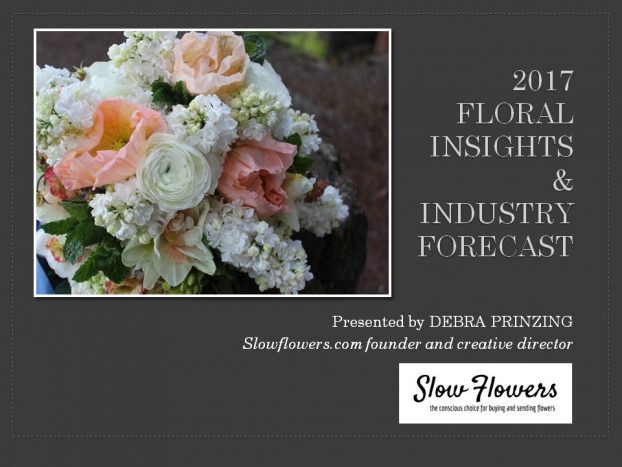
Happy New Year and Welcome to the third annual Slow Flowers’ Floral Insights and Industry Forecast.
Unlike most TREND reports, this compilation tracks changing shifts, emerging ideas and new concepts that are taking hold in the American floral world. Think of it as your Next, New and Now Report. These topics are gleaned from my conversations and interviews that took place with many of you during 2016– Slow Flowers members, including farmers, florists and creatives. I know some of you have already experienced these emerging developments and your influence has inspired this list.
If you would like a copy of this report, please click here: 2017-floral-insights [PDF download]
I look forward to your reaction, thoughts, and input on the Slow Flowers’ Floral Insights and Industry Forecast, including the ideas and themes I may have overlooked! I invite you to share yours in the comment section below.
Let’s get started:
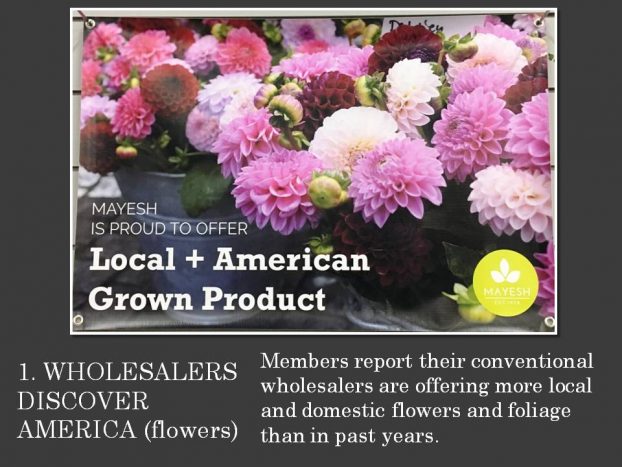
#1 WHOLESALERS ARE DISCOVERING AMERICA. In the midst of global floriculture, with trade in cut flowers estimated at more than $100 billion per year, $13 billion of which takes place in the U.S., we’ve been seduced by the notion that the world is our oyster (or flower field).
In many markets around the country, the wholesale florist is the only commercial cut flowers and foliage source for floral designers, flower shops and studios to purchase product.Yet after branding themselves as the only way to access a world of floral options, some wholesale florists are returning to their roots, at least in part. They are proactively sourcing from American flower farms large and small to stock their coolers and shelves. And beyond this step, many are also using signage and labeling to inform buyers of the origin of that product.
I believe the explosion of farmer-florists and the growth of small-scale floral agriculture in markets across North America has occurred in part because of frustration with the lack of or limited local sourcing by conventional wholesalers. Let me say that again: Farmer-Florists and small-scale floral agriculture have stepped into the gaping void created when wholesalers turned their backs on local flower farmers. And now they’re waking up to the missed opportunity.
The success of the Seattle Wholesale Growers Market, well-documented by me and on this podcast over the past several years, as well as the continued growth of the farmer-owned Oregon Flower Growers Association market in Portland underscore that demand for local flowers is already in place.
Now we are witnessing a shift among some conventional wholesalers to align their brand with American Grown and Locally-grown flowers. Mayesh Wholesale Florist is the most active in this arena, with active support for Slowflowers.com, American Flowers Week, Lisa Waud’s Flower House Detroit, and other sponsorships.
When Mayesh opened its renovated Portland, Oregon, branch in early November, the company asked me to make a design presentation. The team there was very supportive of my request for all locally-grown product — hat’s off to Mayesh and I certainly expect that their success at the cash register will motivate other conventional wholesale florists to get onboard.
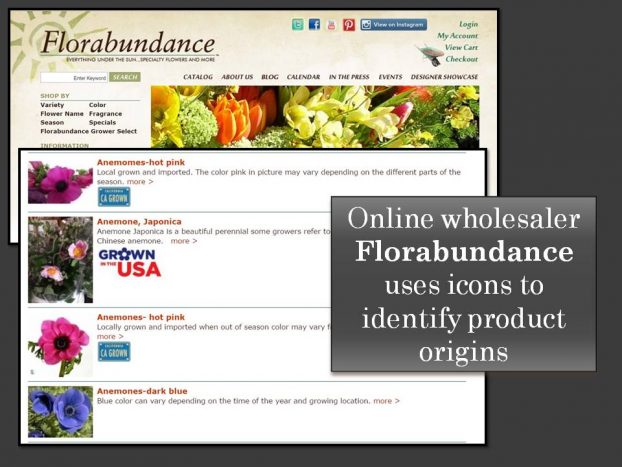
I’ve previously singled out Santa Barbara-based Florabundance, led by Joost Bongaerts, for making the effort to label all California-grown floral and foliage offerings on his online wholesale site. It is an effective tool — one I hope others will emulate. It is certainly a step that demonstrates excellent customer service and an awareness that Florabundance shoppers want to know the origin of the flowers they purchase.
This past fall, I surveyed Slowflowers.com members for their take on a number of topics and trends. When I asked, “If you shop with Conventional Florists, are you finding more American grown and locally-grown product than in the past?” 70 percent of respondents said yes.
Here are a few of the specific comments to elaborate:
- I request American grown from my Rep, and I think there are more boutique, seasonal items that are coming from smaller farmers
- I have been asking my conventional wholesalers to bring in more American grown product and I think it is helping. The “American Grown” branding really helps us to know that is happening.
- It’s definitely taking place and some people at the conventional wholesalers are proud to share that their products are American grown.
This last comment reflects that the industry still has far to go. One member noted:
- It’s a toss up. They say they want to add more but I’m not sure if they are working really hard at. And they don’t do a very good job at advertising what is local and what is not. My Rep knows that I want American grown but still have to ask every time
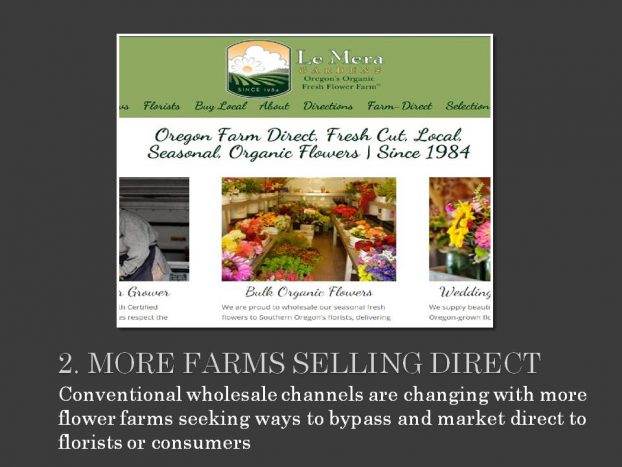
#2 MORE FARMS SELLING DIRECT. This insight is closely connected with item number one.
In general, the conventional wholesale model is changing, as traditional channels of floral distribution are disrupted. I predict that more flower farms will seek and establish new ways to bypass the conventional wholesale pipeline and market direct to florists and consumers. This is a hot topic and certainly one that’s hard to find anyone willing to go on record to discuss.
Our Slow Flowers survey revealed numerous sales channels among flower farmers. Granted, the majority of Slow Flowers farm-members are small-scale producers, but I believe they are the ones modeling how diversification and direct-to-florist commerce can succeed. When asked about their distribution channels, our respondents cited the following top three outlets:
- Seventy percent are growing flowers for their own weddings and event clients;
- This is followed closely by farms selling direct to other florists and wedding designers, at around 67 percent
- With 53 percent of flower farms reporting they sell to local flower shops
After this top tier, the percentages drop down to one third of respondents who sell flowers via farmers’ markets and CSA subscribers (basically consumer-direct) and about one-quarter who sell to local wholesalers and grocery/supermarket buyers.There is another farm-direct model, and here’s where I think the disruption is most revealing. A number of large farms are experimenting with direct-to-florist and direct-to-consumer models.
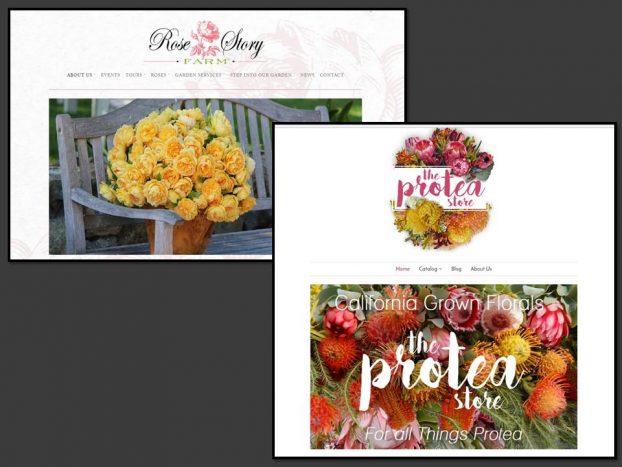
There is another farm-direct model and here’s where I think the disruption is most revealing. A number of large farms are experimenting with direct-to-florist and direct-to-consumer models. A few successful single-crop models have been in place, such as Danielle Hahn’s Rose Story Farm, which in the past few years has shifted almost completely away from selling through wholesalers to florist-direct fulfillment, and many of the Alaska peony growers who sell direct to florists and consumers.
Now, diversified, large-scale growers are beginning to spin off consumer-focused web shops, such as Sun Valley’s Stargazer Barn or Resendiz Brothers’ Protea Store. In the scheme of things, these new ventures are moving only a small fraction of their parent farms’ floral inventory.
But I predict that as large farms bend to demand for farm-direct sourcing of flowers (by consumers and florists alike), the path from field to bouquet will speed up and perhaps take fewer detours through brokers and wholesalers. That means fresher, more seasonal and better value for all floral customers.
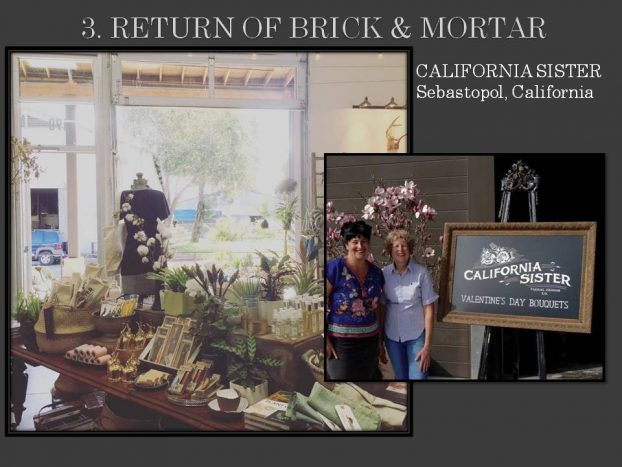
#3 RETURN OF BRICK AND MORTAR
If you rely only on mainstream financial analysis or census data for your intel, then the landscape for brick-and-mortar flower shops looks bleak.
According to the November 2016 Dunn & Bradstreet industry report, there are about 14,000 floral establishments (single-location companies and units of multi-location companies) with combined annual revenue of about $5.5 billion. Yet, the number of flower shops has declined by about 40% since 2000. Dunn and Bradstreet cites a Society of American Florists prediction that the number of retail florists in the US is expected to continue to drop, although the pace is slowing gradually.
OKAY, is this bad news? Not for Slow Flowers members who are opening brick-and-mortar flowers shops across North America.
There’s a lot of flower power going on as independent and progressive florists are signing leases and opening retail spaces in the same markets that have witnessed mainstream mom-and-pop floral storefronts being shuttered.
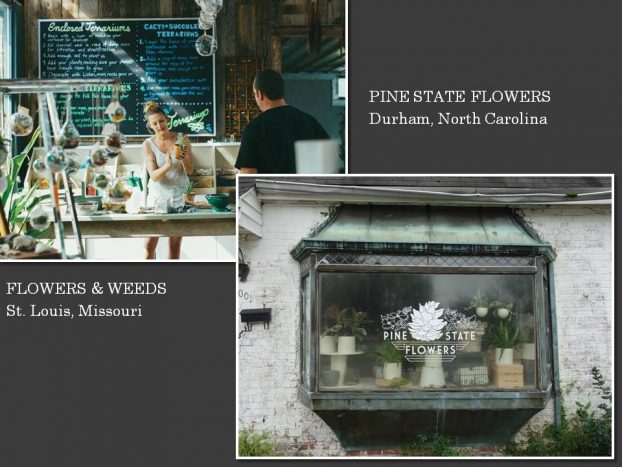 Here are a few examples to share:
Here are a few examples to share:
Grand Rapids, Michigan: Heather Grit of Glamour & Grit just signed a lease on a new storefront to open in early 2017.
In 2016, this podcast covered new retail shop openings in Seattle, with Meredith Isaacson’s Verde & Co., and with with Kathi Greene and Nicole Skalski’s California Sister in Sebastopol, California.
I visited and interviewed other new-retail innovators in St. Louis (Jessica Douglass’s Flowers & Weeds) and Portland (Alea Joy and Sarah Helmstetter’s Solabee; Hilary Holmes of Emerald Petals’ 2nd location; and LauraLee Symes of Sellwood Flower Co.), as well as North Carolina at Maggie Smith’s Pine State Flowers in Durham. And I know there are other relatively new endeavors, including Slow Flowers member Kelli Galloway’s Hops Petunia in Kingston, New York and Ann Brock’s pop-up retail hubs inside Tampa area grocery stores, called Paul and Nate, which I’ll be visiting soon.
Each of these shops enjoys a distinctive brand profile in its marketplace: to support flower farmers in their region; to provide customers with beautiful, local and seasonal blooms; to educate and connect the community with local agriculture and to offer design services that are unique, nature/garden inspired and that tell a story about the flowers used.
This, my friends, is the future of retail, not stores that sell lookalike floral recipes from a corporate web service built on a base of cheap imported flowers.
The innovators are creating retail spaces for not only selling flowers and plants, or the work of local artisans and makers, but for bringing people together to learn and connect. They are important community hubs.
I predict that while the old-fashioned wire-service retail model continues to die, the new-fashioned floral retailer will thrive, connecting with conscious consumers in search of authenticity and integrity.
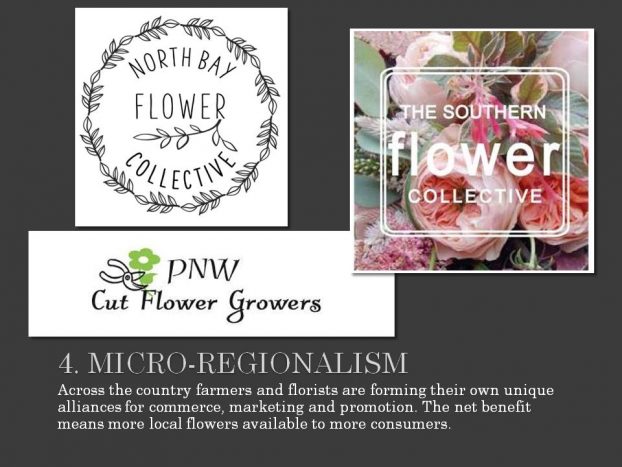 #4 MICRO-REGIONALISM
#4 MICRO-REGIONALISM
Across the country farmers and florists are forming their own unique alliances for commerce, marketing and promotion. The net benefit means more local flowers available to more consumers.
When we surveyed the Slow Flowers Community and asked: “Are you part of a regional network for flower farmers or florists?” 42 percent responded YES. Twenty percent responded “I wish there was a group in my area.”
Based on the activity I’ve witnessed, it is now easier than ever to form such a group – they seem to be popping up all over.
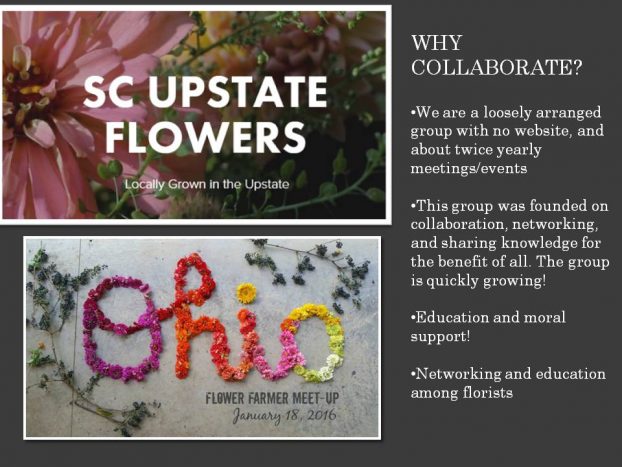
In the past year, I’ve featured several groups on the Slow Flowers Podcast, including the Maryland Cut Flower Growers Association, the Pacific Northwest Cut Flower Growers, the Ohio Flower Farmers’ group, the Greater Seattle Floral Association, the North Bay Flower Collective, the Arctic Alaska Peonies Cooperative, the California Cut Flower Commission, New Orleans Flower Growers Association, the Southern Flower Collective, Hudson Valley Flower Growers Network, as well as networking groups in New England, Denver, Pittsburgh, Raleigh-Durham and upstate South Carolina, thanks to leadership of Slow Flowers Members.
As to the Why? Well, across the board, these groups cite NETWORKING as the number one reason for forming, followed by Marketing and Promotion (42%) and the opportunity to form a Sales/Transportation hub (22%).
There are so many cool collaborations going on. In Massachusetts, Melissa Glorieux of Aster B. Flowers created the Essex Flower Co-op, a flower grower/floral designer cooperative HUB on her farm, which incubates emerging flower farmers in exchange for their volunteer labor. In a number of cities, planning is underway to launch regional wholesale growers markets using co-op, nonprofit or for-profit models to connect florists with local flowers.
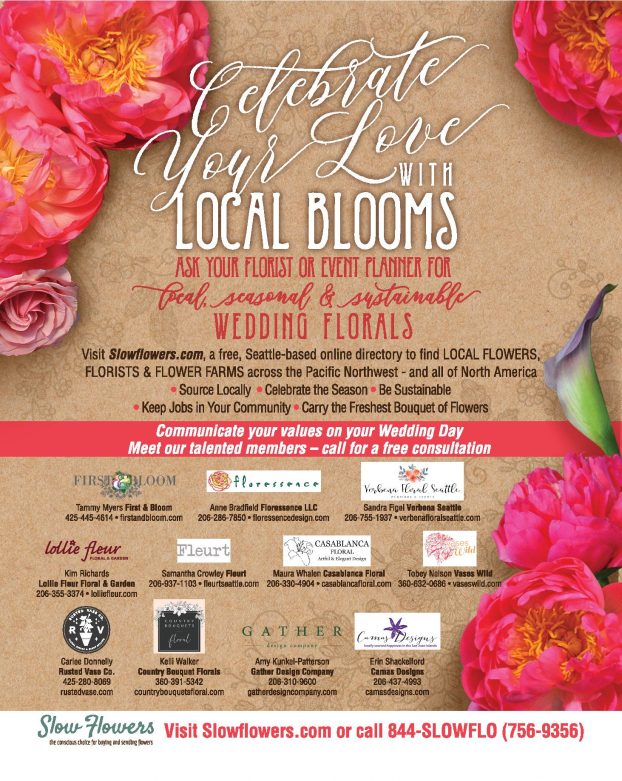 And just this month, eleven Slow Flowers members in Seattle worked with me to pool their marketing dollars to create a beautiful, full-page ad promoting “Show Your Love with Local Blooms” that will appear this month in our area’s top wedding magazine. Bottom line: Each florist spent less than $400 to be part of a full-page ad that none could afford at the rate of $4,200. Innovation and collaboration — equals success for the entire community. If you are interested in replicating this effort with your regional bridal publication, please get in touch!
And just this month, eleven Slow Flowers members in Seattle worked with me to pool their marketing dollars to create a beautiful, full-page ad promoting “Show Your Love with Local Blooms” that will appear this month in our area’s top wedding magazine. Bottom line: Each florist spent less than $400 to be part of a full-page ad that none could afford at the rate of $4,200. Innovation and collaboration — equals success for the entire community. If you are interested in replicating this effort with your regional bridal publication, please get in touch!
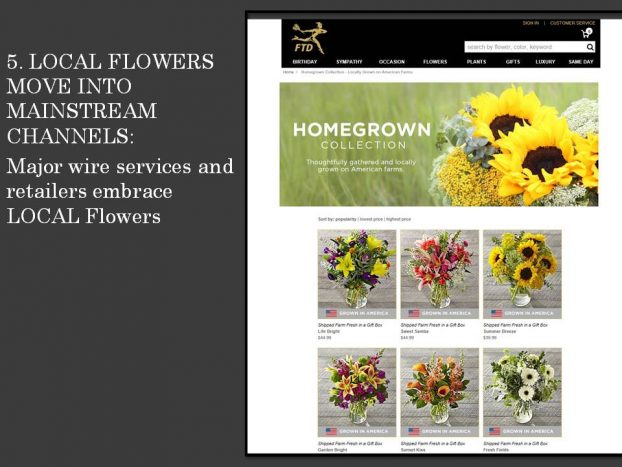
#5 LOCAL FLOWERS MOVE INTO MAINSTREAM RETAIL CHANNELS: Major wire services and mass merchants embrace LOCAL Flowers
Surprise, Surprise! Like Wholesalers who are getting onboard, at least one major wire service, FTD, has determined that there is customer demand for local and American grown flowers. FTD now devotes a single page of its web site to the new “Homegrown Collection,” with the tagline: Thoughtfully gathered and locally grown on American farms.
Bravo! I predict this is just the beginning of mainstream channels acknowledging that the Slow Flowers Movement is a cultural shift, NOT a trend. Now, the question is: will consumers be able to actually find these options?
There onus is on the consumer to type in search terms like “local” or “American grown” — and I have to say I hunted for a while before finding FTD’s devoted page. I urge wire and online flower-sellers to go much further by creating a home page button to sell and market their local or American grown bouquets.
If you come across other offerings, please let me know. My search of Teleflora, 1-800 Flowers, Pro Flowers and Bloom Nation didn’t reveal anything similar to what FTD is doing. SO hurrah, FTD, I hope you exploit this opportunity to lead in your circles.
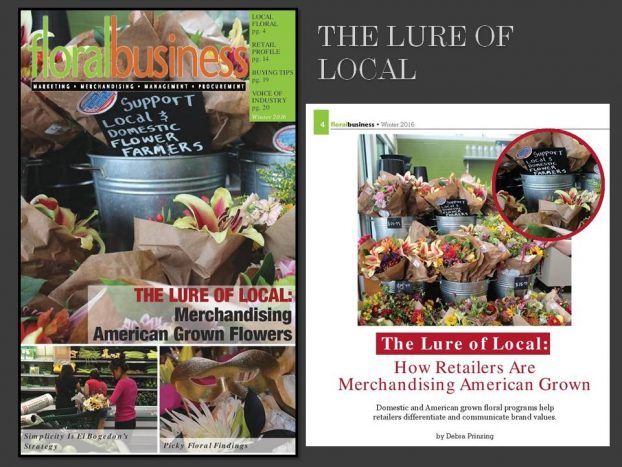
Mainstream also means grocery stores, right? And while the embrace of local flowers represents only a small facet of supermarket retailing, we know the sky is the limit — there’s nowhere to go, but UP.
With some sources saying grocery stores account for no less than 50 percent of all retail floral sales, well, the best thing the Slow Flowers Community can do is remove the barriers that have previously made grocery stores resistant to buying from local and American grown farms.
I am particularly encouraged by the invitation I just received from Floral Business, a quarterly publication of Produce Business, to write the cover story for its Winter 2017 issue.
Entitled “The Lure of Local,” the article features grocery retailing success stories, floral and produce departments that promote local and American grown flowers. This publication reaches 25,000 floral executives making buying decisions for supermarket, mass market and club store floral departments — and now, they’re learning that consumer demand is driving this shift.
It’s impossible to ignore the subtitle of this article: Domestic and American grown floral programs help retailers differentiate and communicate brand values.
Click here to read the entire article.
And here are a few of my favorite stand-out quotes:
“It is important to our consumers to understand where their flowers come from. This transparency not only creates trust and a promise of quality, it provides a sense of community and camaraderie.” — Katie McConahay, Floral Program/ Category Manager, New Seasons Markets
“Break through the clutter of all the products you carry to stand for local and American-grown flowers in ways that your customers see it. Today’s consumer demands that back story about the farmer; they want to connect.” — that’s from a Floral director for a major supermarket chain who asked not to be identified
“Without exception, younger consumers say they value and would pay more for local product because it meant keeping jobs here.” — Steve Dodge, President, Bandy Ranch Floral Corp.
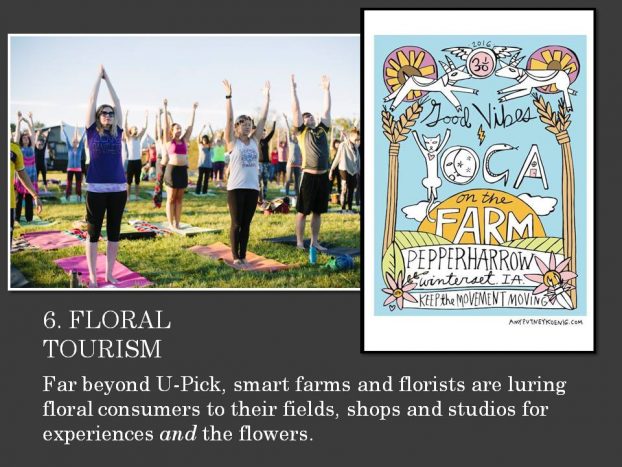
#6 FLORAL TOURISM: Far beyond the seasonal U-Pick offerings, savvy farmers and florists are luring floral consumers to their fields, shops and studios for a combination of inspiring, creative experiences and the flowers.
I’m a longtime veteran of garden and home tours, including having chaired or served on the committees of several such tours over the years. These insider opportunities are popular and successful because they give design and plant lovers a peek indoors, or a chance to step inside the garden gate — to see creative and private environments.
And now, flower farms are getting in on the act and I am calling this act Floral Tourism. You may not yet be able to book your lodging at many flower farms, although one of my all-time favorite things to do as the founder of Slowflowers.com and this podcast is to invite myself to Slow Flowers members’ farms for a visit with my digital recorder.
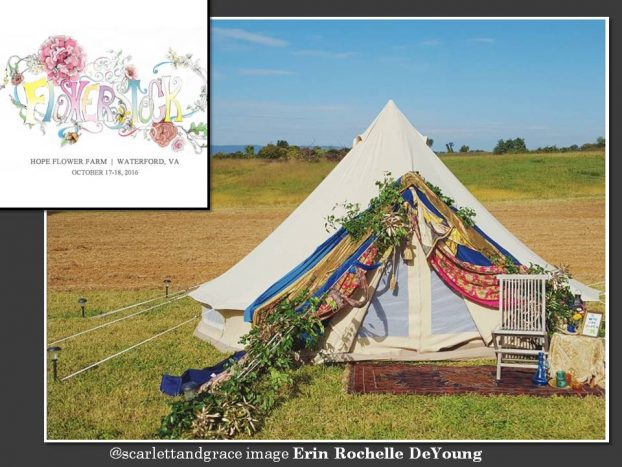 Now, everyone else wants to get in on that act, too! You can rent a glamping tent at Holly Chapple’s 2nd Flowerstock gathering this coming October and you can book a room at Comforts of Whidbey Winery on Whidbey Island in Washington this April when floral designer Tobey Nelson hosts a 3-day retreat and workshop with Susan McLeary.
Now, everyone else wants to get in on that act, too! You can rent a glamping tent at Holly Chapple’s 2nd Flowerstock gathering this coming October and you can book a room at Comforts of Whidbey Winery on Whidbey Island in Washington this April when floral designer Tobey Nelson hosts a 3-day retreat and workshop with Susan McLeary.
Adam and Jennifer O’Neal of Pepperharrow Flower Farm in Winterset, Iowa, have staged three annual Yoga on the Farm festivals, which earn my award for the most creative agrotourism event on a flower farm. PepperHarrow Farm is a quaint, biodynamic, 20-acre family farm devoted to creating a local whole food system with bees, heirloom fruits and veggies and heritage animals. And perhaps you met the O’Neals when I featured them in an episode of the Slow Flowers Podcast a few months ago.
Their annual Yoga on the Farm at PepperHarrow is an all-day festival featuring music, food trucks, a fun-filled kid’s area, overnight camping and local vendors with art, merchandise and massages! All proceeds for the donation-based event go toward building the farm’s infrastructure. Tickets are $40 for adults. Kids under 18 are free. I love this community-minded celebration that draws yoga and floral enthusiasts from around their region. Certainly it is a ton of work to pull off, but the event builds strong relationships with customers who return for other PepperHarrow events, workshops and flowers, all year long.
Lisa Waud of Detroit’s Flower House made traveling for floral experiences a big part of 2015 and then again this year when she staged a five-day series of lectures, workshops, demonstrations and a fantastic dinner inside the Detroit Public Library during Detroit Flower Week.
More than ever, design schools and flower farms are producing floral-themed experiences – from tours to private workshops. In Wine Country, there’s Dragonfly Flower Farm’s involvement with an event called Sonoma County Living – The Best of Healdsburg An Interactive Experience of Food, Wine & Floral; and nearby, where I have taught, the Russian River Flower School stages short- and longer workshops and farm tours, complete with dining experiences.
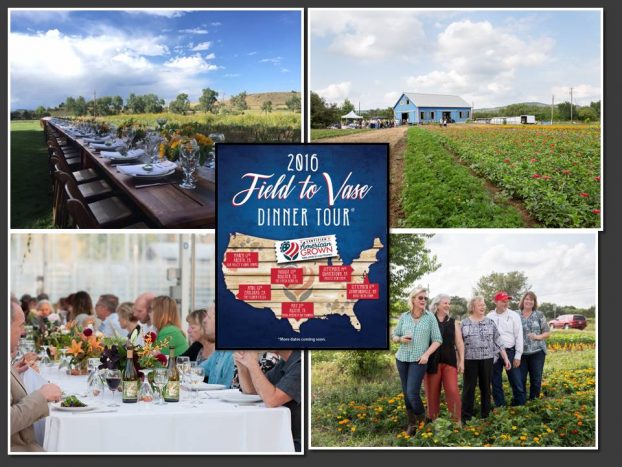
For elegance and effective messaging, the Field to Vase Dinner Tour series is the ultimate farm-dining experience. To date, the tour has taken place at 18 venues during 2015 and 2016, from Washington State to Washington, D.C.; from Brooklyn to Boulder; from Austin to Detroit.
At each of these events, there is a guided farm tour led by the host farmer and after dinner, guests take home a beautiful bouquet of flowers. I’ve served as a co-host for each of these and Slow Flowers has been an in-kind sponsor of the tour, so I have had a front-row seat to the fun. Yes, the food and wine are delicious – and local – but flowers are the stars of these experiences, which will continue in 2017 at even more American flower farms.
Truly, there is a cultural shift symbolized by the many inspiring ways that the Slow Flowers community connects consumers with local flowers. I’m excited to see what you create in 2017 — and move over wineries! Tourism is coming to America’s flower farms.
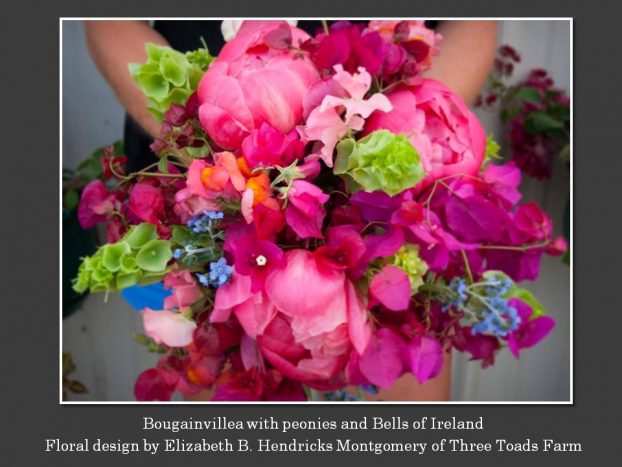
#7 LUXE AND LUSH TROPICALS MIX BEAUTIFULLY WITH GARDEN ANNUALS AND PERENNIALS
Perhaps it’s because most tropical flowers and leaves are bold, graphic and distinctly colorful or patterned, but I’ve been noting a renewed fascination with these elements in design. The update is in the mix. The most interesting tropical-infused arrangements and bouquets are not singularly island-themed. These elements are used as accents that spice up garden-inspired bouquets.
It’s an exciting old-new approach — borrowing the best ingredients from 1970s, ’80s and ’90s corporate office and hotel lobby arrangements and plucking one or two iconic floral or fern shapes to add a note of surprise to a looser, naturalistic arrangement.
If you can’t find American grown sources for caladium, canna, croton, anthurium, ginger or bougainvillea, then grow these plants as summer annuals. Or, make a trip to your local garden center or nursery. There’s lots to choose from and I predict we’ll begin to see softer palettes — apricot, cream, pale green and yellow, for example, in cultivars introduced by breeders who catch onto this design shift.
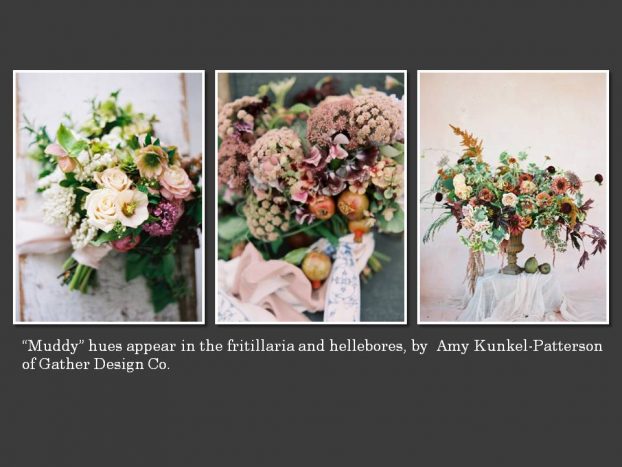 #8 COLOR UPDATE — Beyond Blush
#8 COLOR UPDATE — Beyond Blush
In my first Slow Flowers Industry Forecast two years ago, I cited Bright pastels and Saturated Jewel Tones as an emerging palette that promised to be richer and more vivid, reflecting a deeper petal color. This was notable as a possible shift beyond the crazy for blush-toned ‘Cafe au Lait’ dahlias, especially in bridal. That same year Pantone declared MARSALA as its color of 2015, so I wasn’t far off in predicting richer, vivid floral palettes, including watermelon pink, orchid purple and cerise red.
Here we are, with 2017 on the horizon and the Pantone color of the year is “greenery,” a huge relief to those of us who love foliage-themed bouquets (and P.S., that was another insight I shared in 2015).
According to many of you, blush is still going strong. Yet, the spectrum for wedding flowers is broadening, and two themes are emerging as favorites among Slow Flowers farmers and designers: Butter Yellows and Muddy Neutrals. Thanks to Slow Flowers member Amy Kunkel-Patterson of Gather Design Co. for sharing some of her bouquet designs that illustrate both these color palettes beautifully — have fun infusing buttercreams and tans/beiges/coffee tones into your designs in 2017.
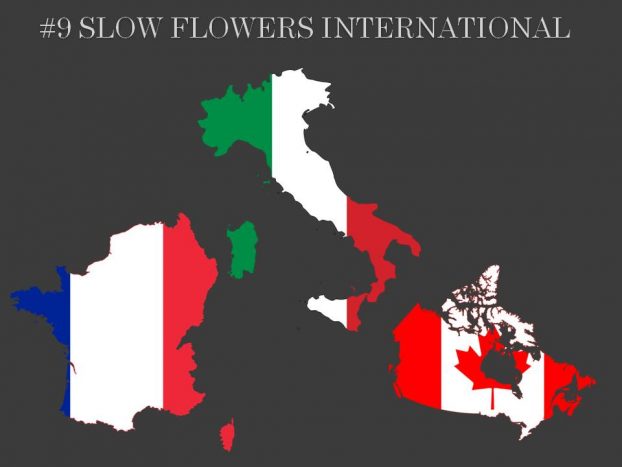 #9 SLOW FLOWERS INTERNATIONAL
#9 SLOW FLOWERS INTERNATIONAL
In 2016 we launched the CANADA section of Slowflowers.com — and I’m happy to report that we have 15 flower farmers and floral designers included in this directory — with so much more potential to expand participation in Canada!
We’ve continued to cross-promote the homegrown flowers story with our friends in the UK, including Flowers from the Farm, a nationwide network of cut flower growers, and the amazing British Flowers Week, an annual flower promotion campaign of the New Covent Garden wholesale flower market.
How exciting to learn that this past September, the Australia Flowers Week initiative launched, inspired by British Flowers Week and our own Slow Flowers-supported American Flowers Week.
Since then, local flowers enthusiasts in Italy and France have asked for our endorsement and support as they develop Slow Flowers collectives in their countries, and this has prompted our initial efforts to form Slow flowers international. All I can say is WOW — I never thought this idea would explode and be so inclusive and universal. Keep your eyes and ears in this space — more to come.
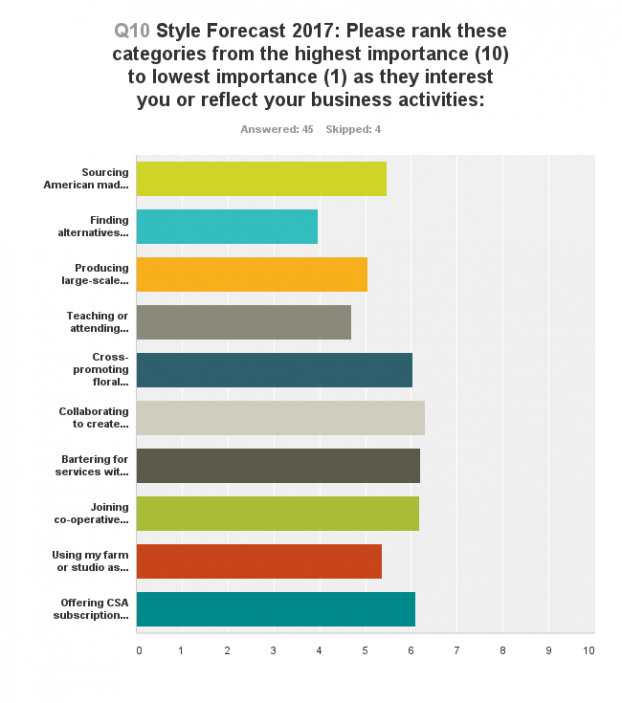 As a wrap-up, I want to share the Hot 2017 Topics as ranked by Slow Flowers members who responded to our annual survey. These reflect the personal business goals of our members. We’ll call them “New Years in Flowers Resolutions”:
As a wrap-up, I want to share the Hot 2017 Topics as ranked by Slow Flowers members who responded to our annual survey. These reflect the personal business goals of our members. We’ll call them “New Years in Flowers Resolutions”:
#1 Collaborating to create “styled” photo shoots for PR/editorial
#2 Bartering for services with vendors, farmers, photographers, etc.
#3 Joining co-operative ventures such as co-farming
#4 Offering CSA subscription services for flowers or bouquets
#5 Cross-promoting floral workshops with other lifestyle categories (calligraphy, cooking, wine-tasting, etc)
#6 Sourcing American made products (vases, tools, ribbons, other supplies)
#7 Using my farm or studio as an event space
#8 Producing large-scale floral installations for weddings/events
#9 Teaching or attending floral workshops
#10 Finding alternatives for conventional floral foam in my designs
Whew ! Thanks for hanging in there with me as I shared my insights and our Slow Flowers Forecast for 2017.
A TREND, TO TREND, TRENDING
While wrapping up this report, I looked up the definition of the word TREND and here’s what I found:
TREND is a noun as well as a verb. The most commonly used definition is “fashion,” as in “the latest trend in floral design.” Synonyms include vogue, style, mode, crazy, mania or rage. And this is why I typically avoid the term TREND when discussing the Slow Flowers Movement. Instead, I often use the phrase “cultural shift,” originated by my very first Podcast guest in 2013, consumer behavior and marketing expert Kierstin DeWest of Conscientious Innovation.
There is a second definition for TREND as a noun: “a general direction in which something is developing or changing,” as in “an upward trend in sales and profits.” Or its synonyms: tendency, movement, drift, swing, shift, course, current, direction, progression, inclination, leaning and more.
As a VERB, “to trend” has an equally valuable meaning: to change or develop in a general direction, as in “local flowers are trending upward.” Synonyms include: move, go, head, drift, gravitate, swing, shift, turn, incline, tend, lean and veer.
So, maybe it’s okay to say Slow Flowers is the trend or trending for 2017 after all. As always, I welcome your response, reaction and comments!
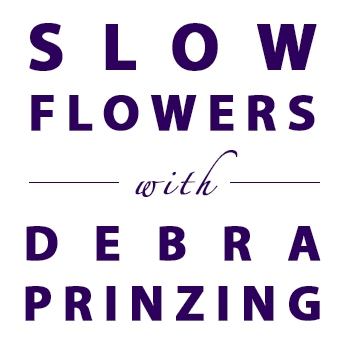 The Slow Flowers Podcast has been downloaded more than 143,000 times by listeners like you.
The Slow Flowers Podcast has been downloaded more than 143,000 times by listeners like you.
We ended the month of December with more than 9,000 downloads — an all-time high for listenership!
THANK YOU to each one of you for downloading, listening, commenting and sharing. It means so much. How exciting to know we’ll hit 200,000 downloads in 2017.
If you value the content you receive each week, I invite you to show your thanks and support the Slow Flowers Podcast with a donation — the button can be found on our home page in the right column.
Your contributions will help make it possible to transcribe future episodes of the Podcast.

Thank you to our lead sponsor returning for 2017: Certified American Grown Flowers. The Certified American-Grown program and label provide a guarantee for designers and consumers on the source of their flowers. Take pride in your flowers and buy with confidence, ask for Certified American Grown Flowers. To learn more visit americangrownflowers.org.
Arctic Alaska Peonies has also returned as a major sponsor for this year. Arctic Alaska Peonies is a cooperative of 50 family farms in the heart of Alaska providing high quality, American Grown peony flowers during the months of July and August. Visit them today at arcticalaskapeonies.com
More sponsor thanks goes to Syndicate Sales, an American manufacturer of vases and accessories for the professional florist. Look for the American Flag Icon to find Syndicate’s USA-made products and join the Syndicate Stars loyalty program at syndicatesales.com.
A big bouquet of thanks goes to Longfield Gardens… providing home gardeners with high quality flower bulbs and perennials. Their online store offers plants for every region and every season, from tulips and daffodils to dahlias, caladiums and amaryllis. Visit them at lfgardens.com.
And finally, thank you Association of Specialty Cut Flower Growers. Formed in 1988, ASCFG was created to educate, unite, and support commercial cut flower growers. It mission is to help growers produce high-quality floral material, and to foster and promote the local availability of that product. Learn more at ascfg.org
I’m Debra Prinzing, host and producer of the Slow Flowers Podcast. Next week, you’re invited to join me in putting more American grown flowers on the table, one vase at a time. And If you like what you hear, please consider logging onto Itunes and posting a listener review.
The content and opinions expressed here are either mine alone or those of my guests alone, independent of any podcast sponsor or other person, company or organization.
The Slow Flowers Podcast is engineered and edited by Andrew. A very special thank you to Andrew for his tireless and loyal support. He shows up and edits this podcast week in and week out — and it’s such a gift to work with him. Learn more at shellandtree.com.









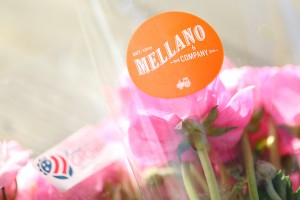
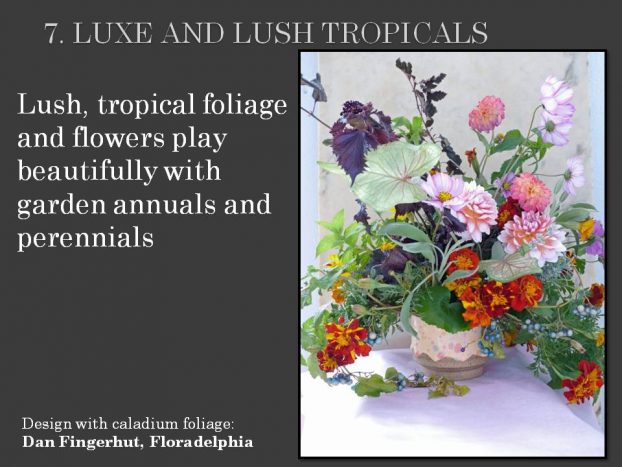
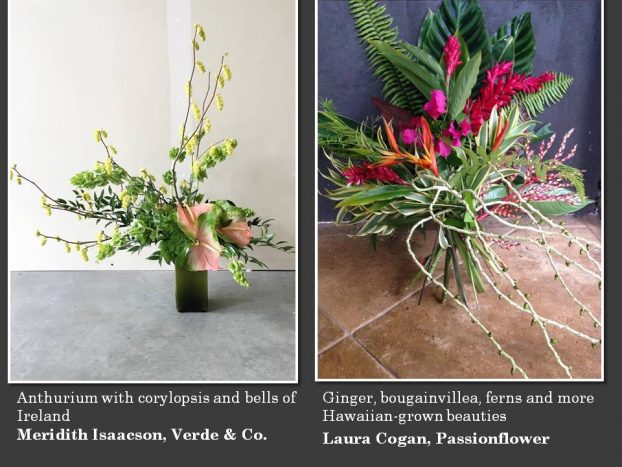
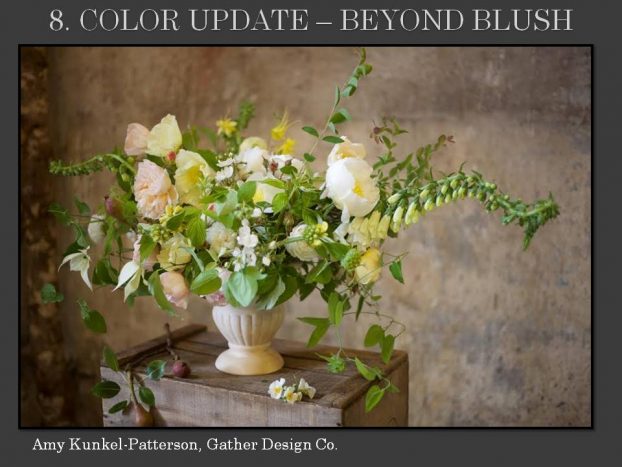

January 4th, 2017 at 3:48 pm
Thank you for compiling so much useful information Debra! And thank you for including Le Mera Gardens My favorite graphics is Slow Flowers International, I found it moving.
My favorite graphics is Slow Flowers International, I found it moving.
You are my role model, Joan! Thanks for commenting – xo Debra
January 4th, 2017 at 5:47 pm
This was my first podcast I listened to. Thank you so much for the insight of 2017. Leaves me even more excited and hopeful that there is a niche for my American fresh cut flowers. Thank you for being a strong voice for our surging industry!
Teresa Brown
Rooster Ridge Farms LLC
thanks for your sweet comments, Teresa! I’d love you to join Slowflowers.com in 2017! Click on over to Create a Listing! — Debra
January 5th, 2017 at 9:22 am
Debra, I hope you take some credit for all things good that are happening in the floral industry. You are our champion, and I am certain that without your amazing leadership very little of this would have happened. THANK YOU for all your amazing efforts!!
Thank YOU, Tobey! It’s all about mutual support and creating our own tribe, right?!–Debra
January 11th, 2017 at 6:59 am
[…] Airing today’s conversation with Hilary is a timely follow-up to last week’s episode when we released our 2017 Floral Insights and Industry Forecast. […]
January 31st, 2017 at 1:07 pm
[…] continues to grow, especially among studio florists and style- and eco-conscious couples. A recent Slow Flowers survey and Industry Insights Report also confirmed the uptick in consumers’ and designers’ use of U.S.-grown and locally-grown […]
February 22nd, 2017 at 8:00 am
[…] I compiled the Floral Industry Insights for 2017, a forecast of the most exciting shifts taking place in the progressive Slow Flowers Movement, I […]
March 8th, 2017 at 9:15 am
[…] you recall, I cited “return of brick and mortar flower shops” as an emerging 2017 floral industry theme. The launch of Windmill Floral Studio reflects this insight, but also hints at a possible shift for […]
August 14th, 2017 at 2:05 am
thank you for sharing this looks pretty cool
October 4th, 2017 at 8:01 am
[…] my 2017 Floral Insights & Industry Forecast, released at the beginning of this year, I noted Shift #3 — “Return of Brick and […]
November 8th, 2017 at 9:47 am
[…] love reading this report and to be honest, it has served as a template for my much younger Slow Flowers Floral Insights and Industry Forecast, which I started compiling annually four years […]
December 27th, 2017 at 2:57 pm
[…] Pacific Northwest Cut Flower Growers meetup that month, held in Corvallis, Oregon. I shared the 2017 Floral Insights & Industry Forecast as part of my SLOW FLOWERS, AMERICAN STYLE presentation. I was thrilled to discuss what’s […]
January 6th, 2021 at 10:21 am
[…] a huge congratulations to the many Slow Flowers Survey responses that were spot on about YELLOW. In 2017, Slow Flowers’ Floral Forecast predicted soft yellows in an insight titled: “Bey… It has taken four years since then for Pantone to agree! Let me include a few of your comments here […]